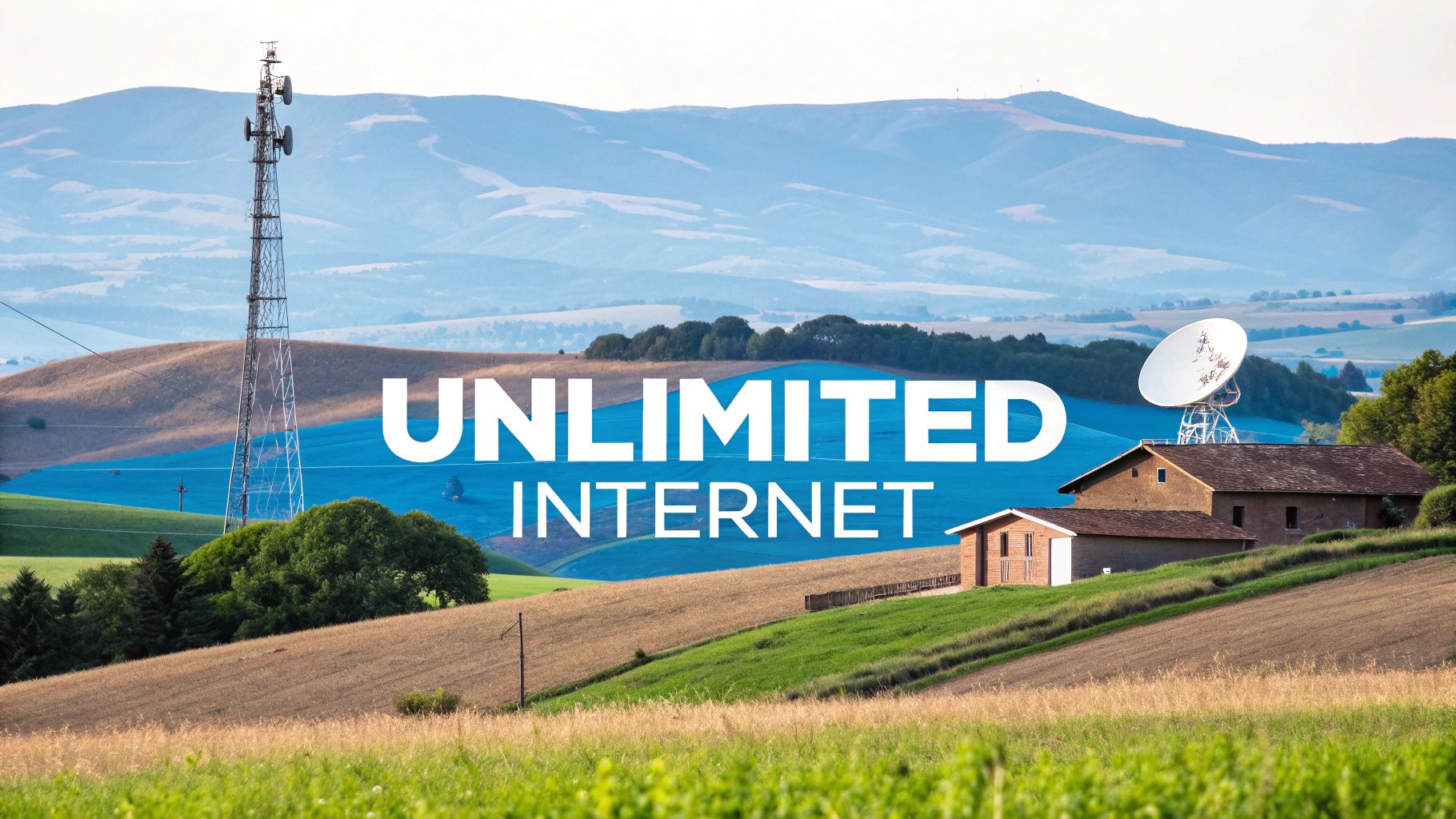

· Por James
Discover Reliable Rural Unlimited Internet Options
That soul-crushing feeling of a loading screen spinning endlessly while you're surrounded by beautiful countryside? It’s a frustration just about every rural resident or RVer knows intimately. For way too long, fast, dependable internet felt like something reserved for city folks, leaving everyone else to deal with sluggish, data-capped connections.
But that’s all changing. Rural unlimited internet is no longer a pipe dream; it's here, powered by modern tech like 5G and satellite that finally brings high-speed, buffer-free streaming and working to life, far beyond the city limits.
Finally Solving the Rural Internet Puzzle
You know the scene: you're trying to get some work done or just relax with a movie, but your internet has other plans. This "digital divide" has been a major headache for rural homes, farms, and anyone living a mobile lifestyle in an RV. It affects everything—remote work, online classes for the kids, and even just trying to stream your favorite show.
The good news is that the demand for better options has exploded, pushing companies to innovate and finally solve this puzzle. Think of the following as a roadmap, showing how we got from constant buffering to reliable connectivity.
This visual breaks down the journey from those common frustrations to the modern solutions delivering true unlimited internet today.
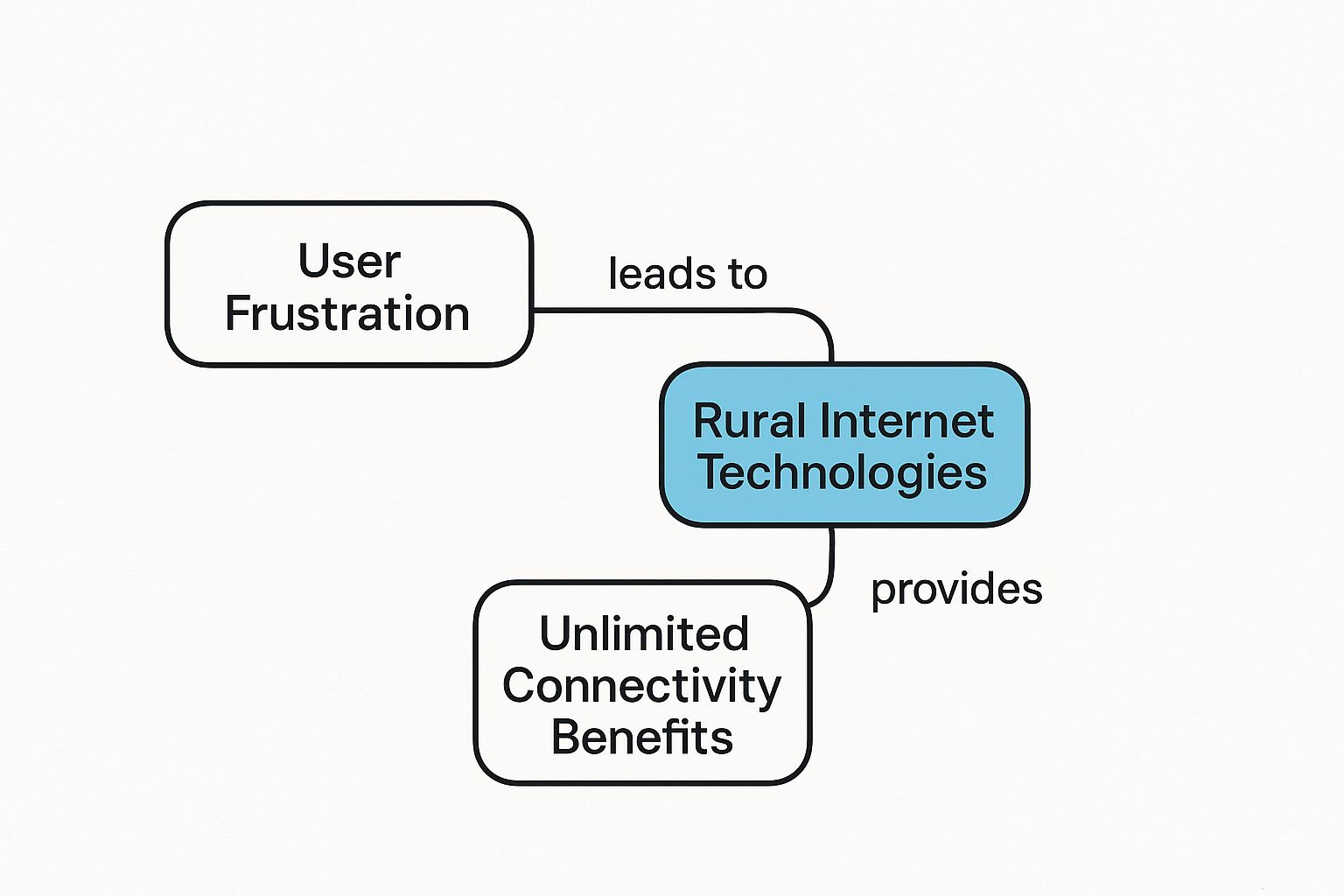
As you can see, the new wave of technology directly tackles the biggest pain points for rural users, opening up a world of seamless remote work and uninterrupted entertainment.
Why Rural Connectivity Is Gaining Momentum
This shift isn't just something a few people are talking about; it's a massive market trend. With more people working from home and embracing a connected lifestyle, reliable internet has shot to the top of the priority list for those outside of urban centers.
This spike in demand is fueling huge investment and innovation. In fact, the global Rural Internet System market is on track to hit around USD 150 billion by 2025, growing at a strong 18% each year. This boom is driven by everything from smart farming technology to the ever-growing remote workforce. For a deeper dive, you can check out the full rural internet market research.
The biggest hurdle has always been infrastructure. For traditional providers, laying miles of fiber-optic cable for just a handful of customers never made financial sense. That’s precisely why these alternative wireless technologies are becoming so critical.
The Promise of True Unlimited Data
If you’ve ever found yourself nervously checking your data usage halfway through the month, the idea of rural unlimited internet feels like a breath of fresh air. It’s not just about more data; it’s about freedom.
Finally, you can:
- Work from anywhere: Jump on video calls, send massive files, and collaborate with your team without worrying about your connection dropping or hitting a data cap.
- Stream without limits: Binge-watch your favorite shows in high-definition on multiple TVs, tablets, and laptops at once—with zero buffering.
- Support a modern household: Keep your smart home devices, gaming consoles, and all your family’s gadgets connected without dragging down your speed.
- Travel with confidence: For RVers and digital nomads, it means you can explore off-the-beaten-path locations while staying reliably connected to work, family, and entertainment.
This guide will walk you through the technologies making all of this possible, helping you understand your options and choose the perfect service for your lifestyle.
Comparing Your Rural Internet Technology Options
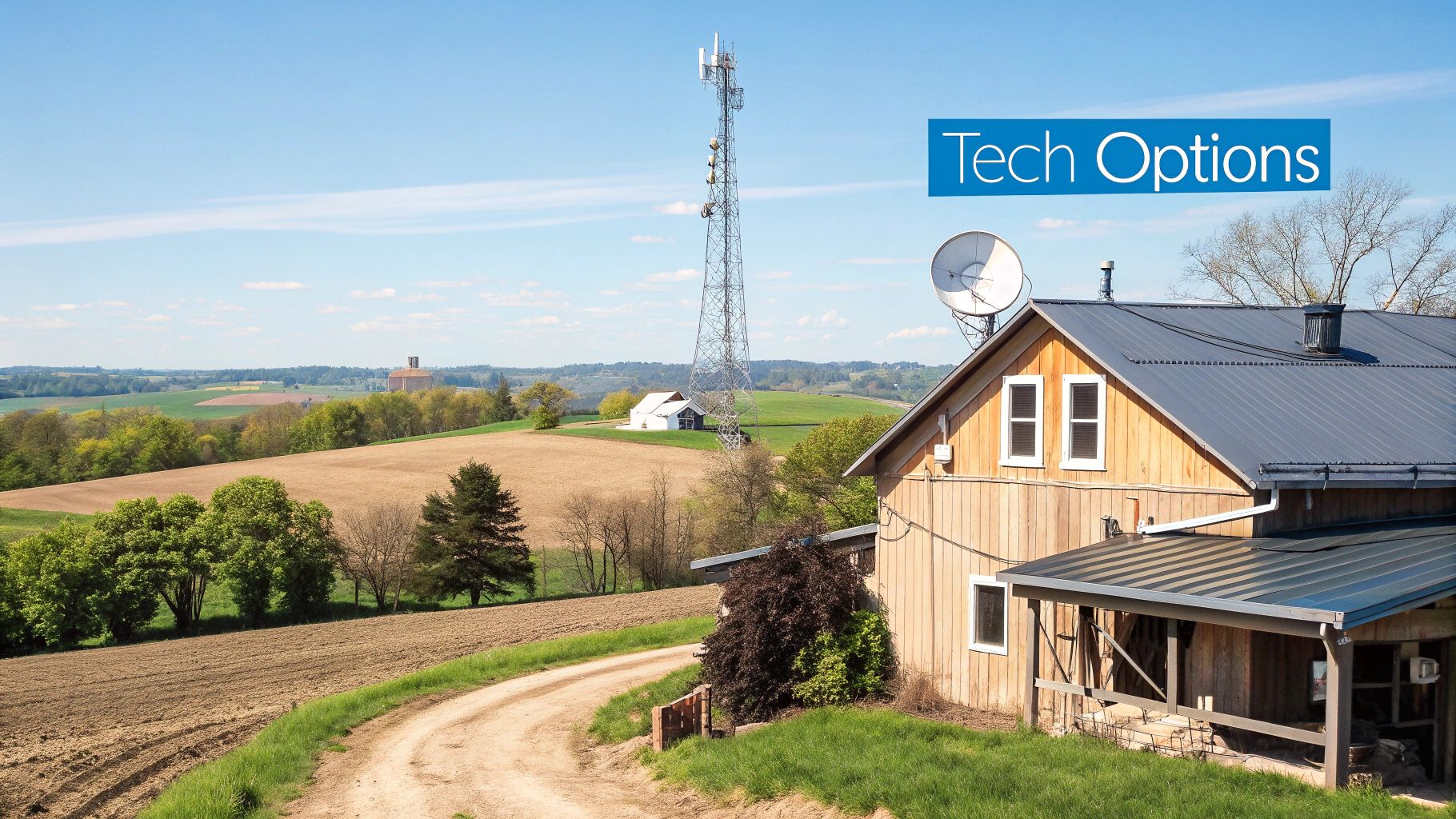
Trying to find good rural unlimited internet can feel like you're learning a new language. You hear terms like satellite, 5G, and DSL, but it’s tough to know what they actually mean for your home. The secret is to understand how each one works in the real world, not just on a spec sheet.
Think of it like this: every internet type is a different kind of delivery service. Some are like a high-speed courier that zips directly to your door, while others have to take a long, winding route to get there. Let's break down the main players so you can see which one is the right fit for your neck of the woods.
Satellite Internet: A Signal From The Sky
For a long time, satellite internet was the only game in town for much of rural America. It can reach just about any spot on the map, as long as you have a clear view of the sky. The technology is straightforward: a signal travels from a station on the ground, up to a satellite orbiting the Earth, and then beams back down to a dish on your roof.
Imagine you're playing a long-distance game of catch. The ball (your data) has to travel a huge distance up and back down, which creates a noticeable delay. That delay is called latency. While newer services like Starlink have made huge strides in cutting down this lag, traditional satellite often struggles with it, making real-time stuff like online gaming or glitch-free video calls a frustrating experience.
We dive deeper into the specifics in our complete guide to satellite internet for rural areas.
5G Fixed Wireless Internet: The Local Powerhouse
Now, picture a dedicated, high-speed lane on the highway built just for you. That’s pretty much what 5G Fixed Wireless internet feels like. Instead of a signal traveling thousands of miles into space and back, it travels a much shorter distance from a nearby cell tower directly to a receiver in your home.
This is a complete game-changer for rural unlimited internet for a few big reasons:
- Low Latency: Because the signal path is so short, data travels almost instantly. This means no frustrating lag during video calls, streaming, or online gaming.
- High Speeds: 5G networks are built to handle a ton of data, giving you download and upload speeds that can easily go toe-to-toe with city cable internet.
- Quick Installation: Forget waiting for a technician. Setup is often as simple as plugging in a small gateway device and getting online in minutes.
The only catch? Availability. You have to be within range of a provider’s 5G tower. The good news is that these networks are expanding into more rural communities every single year, bringing reliable, fast internet with them.
Key Takeaway: For most rural folks who are in a coverage zone, 5G Fixed Wireless delivers the best mix of speed, low latency, and reliability. It's simply a better choice than traditional satellite for just about everything you do online.
The Old Guard: DSL and Fiber
To really appreciate the new options, it helps to know about the technologies that have been around for a while—and often let rural areas down.
Digital Subscriber Line (DSL) piggybacks on old-school telephone lines. Think of it as sending your data down a narrow, bumpy country road. The farther you live from the provider's central office, the slower and more unreliable your connection gets. This is why DSL is famously sluggish in most rural settings.
Fiber-Optic Internet is the absolute gold standard. It uses light to send data through glass cables, making it mind-blowingly fast and stable—like a futuristic bullet train. The problem is the cost. Laying fiber-optic cable across vast, sparsely populated areas is incredibly expensive, so it remains a rare luxury outside of towns and cities.
Each technology has its place, but as you look at your options, it's clear that some are better suited for the demands of modern life. For a great look at how satellite is evolving, exploring Starlink as a leading rural internet option gives you a sense of where things are headed.
Rural Internet Technologies at a Glance
This side-by-side comparison highlights the key differences between common rural internet options, helping you quickly identify which technology best aligns with your needs for speed, latency, and availability.
| Technology | Typical Speeds | Latency | Rural Availability | Best For |
|---|---|---|---|---|
| 5G Fixed Wireless | 50-300+ Mbps | Low | Growing rapidly | Streaming, gaming, remote work, general household use |
| Satellite (LEO) | 50-250 Mbps | Low-Medium | Good | Remote/off-grid locations, streaming, general use |
| Satellite (GEO) | 12-100 Mbps | High | Excellent | Basic browsing & email where no other options exist |
| DSL | 1-25 Mbps | Medium | Fair (declining) | Very light use (email) if it's the only choice |
| Fiber-Optic | 100 Mbps - 2 Gbps | Very Low | Very Limited | Everything, but finding it is the hard part |
Ultimately, the right choice comes down to what's available at your specific address and what you plan to do online. For a growing number of rural homes, 5G is finally delivering the speed and reliability they've been waiting for.
How to Choose the Right Internet Provider
Picking a provider for rural unlimited internet isn't just about chasing the fastest advertised speeds. When you're out in the country, the little details make a huge difference—from whether the signal actually reaches your specific address to the fine print hiding in the contract. To make the right call, you have to look past the flashy marketing and start asking the tough questions.
This checklist is your practical guide to cutting through the noise and finding a service that truly delivers. We'll walk through everything from reading between the lines on coverage maps to understanding what "unlimited" really means, and how to spot all the hidden costs. Think of this as your roadmap to choosing a provider that genuinely works for your home or RV.
Verify Coverage and Real-World Speeds
First things first: you absolutely have to confirm that a provider can deliver a strong, stable signal to your exact location. A company's official coverage map is a decent starting point, but it's often more of an optimistic guess than a guarantee of quality service at your front door.
Treat those maps like a weather forecast—they give you the general picture, but you still need to check the conditions at your own house. Things like trees, hills, and even the materials your home is built from can weaken a signal. The best providers know this and will offer a risk-free trial period or perform a precise signal check on-site before you're locked in.
This step is so important because performance can drop off dramatically outside of city limits. Across OECD countries, fixed broadband download speeds in rural areas are, on average, 24 percentage points lower than in urban areas. The gap is even bigger for mobile broadband, at a whopping 35 percentage points. This data shows exactly why you need to verify the actual speed you can get, not just the "up to" number in the ad. You can discover more insights about rural connectivity challenges on oecd.org.
Unpack the "Unlimited" Data Promise
The word "unlimited" can be tricky. While many plans won't have a hard cap that cuts off your service entirely, they almost always include a Fair Use Policy or a data deprioritization threshold. This means after you blow past a certain amount of data in a month (often around 1TB), the provider can legally slow down your connection during peak hours when the network is busy.
For the average person streaming movies and browsing online, this might never be an issue. But for a household with multiple heavy users, remote workers slinging large files, or serious gamers, hitting that threshold is a real possibility. Always ask what the deprioritization limit is.
Here are the key questions you need to ask any potential provider about their "unlimited" plans:
- What is the specific data threshold for deprioritization?
- How much are speeds throttled when traffic is deprioritized?
- Does this policy apply to all plans, or do you offer premium tiers with higher (or no) thresholds?
Evaluate Latency and Total Cost
Speed isn't the only thing that matters. Latency, which you might know as "ping," is the time it takes for a signal to travel from your computer to a server and back again. High latency is what causes that annoying lag on video calls and makes online gaming a nightmare. For a smooth experience, you'll want a latency under 100 milliseconds (ms). If you’re a competitive gamer, you need it to be under 50 ms.
Finally, do the math on the total cost, not just the monthly bill. Hidden fees can pop up and turn a seemingly good deal into a budget-buster. Make sure you get the full story on:
- Hardware Fees: Do you have to buy or rent a router, modem, or dish?
- Installation Charges: Is there a one-time fee for a professional to come out and set it up?
- Activation Fees: Some companies charge you just to flip the switch on your service.
- Contract Terms: Are you signing up for a multi-year contract with hefty early termination fees?
Digging into these details is how you make a truly informed choice. To help you weigh your options, you might find our guide on finding the best rural internet provider useful, as it breaks down what to look for in more detail.
Optimizing Your Setup for Peak Performance
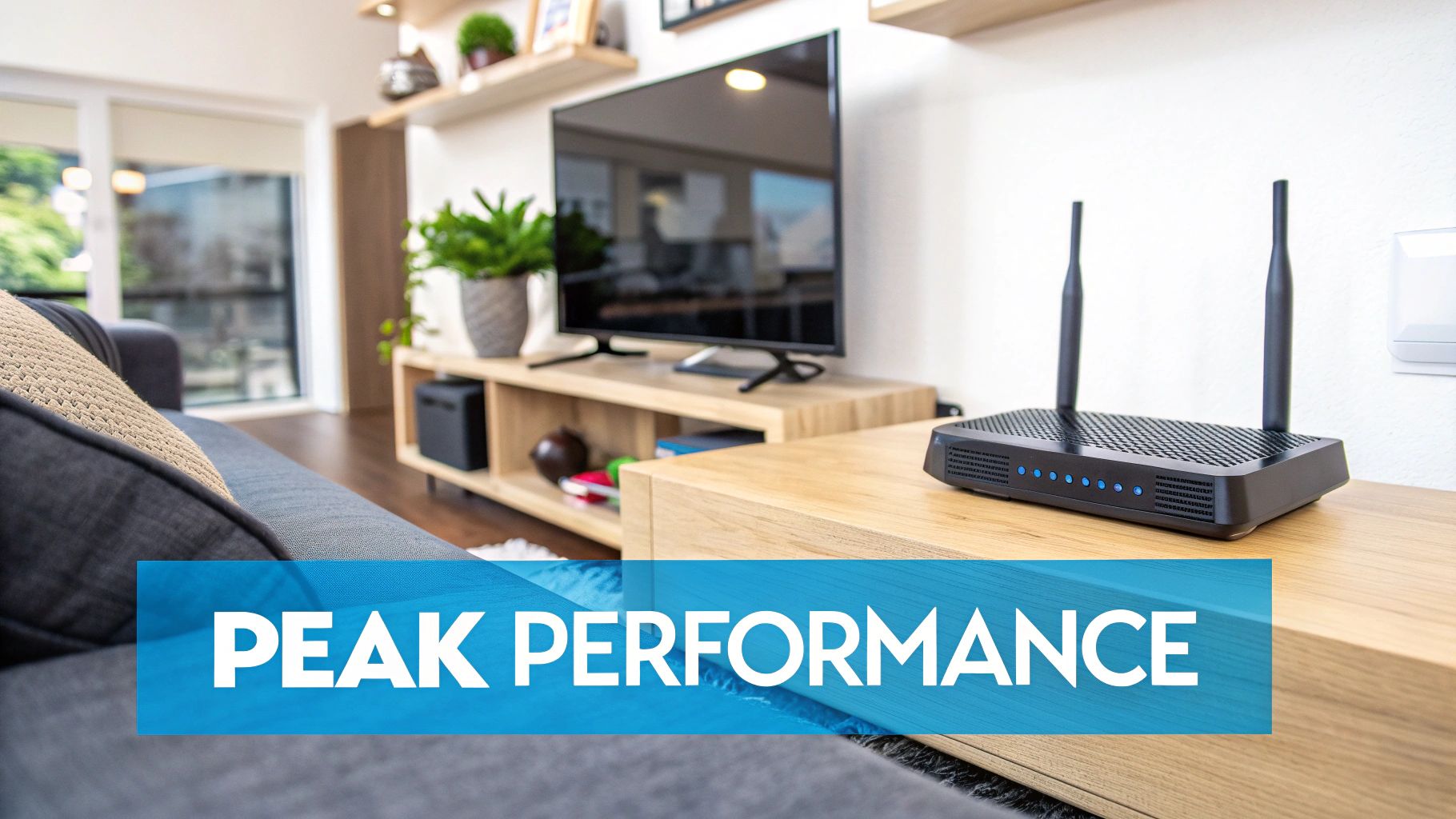
Getting your rural unlimited internet service up and running is a huge win. But to really get your money's worth, a few simple tweaks can turn a good connection into a great one.
Think of it like tuning a guitar. It works right out of the box, sure, but a little adjustment makes the music sound perfect. By being strategic with your equipment, you can squeeze every last drop of speed out of your plan.
You don't need to be a tech wizard to do this, either. From finding the "sweet spot" for your router to stretching your Wi-Fi across a large property, these tips will help you dial in your network for work, streaming, and everything in between.
Finding the Right Spot for Your Equipment
Where you put your router or satellite dish is probably the single most important factor for a strong, steady signal. It’s about more than just finding a convenient outlet; placement is everything.
Imagine your router is a bare lightbulb. The closer you are and the fewer walls in the way, the brighter the light. Your Wi-Fi signal works the exact same way, and common household materials can dim or even block it completely.
Key Insight: Everyday obstacles can tank your internet speeds. One study found that concrete can block up to 90% of a Wi-Fi signal, and even materials like plaster and wood can cause major interference.
Here’s how to sidestep those signal killers:
- Go High and Central: Place your router on a high shelf or in the most central location you can. This lets the signal radiate downward and outward, covering more ground.
- Avoid Obstructions: Keep it clear of thick walls, big metal appliances like refrigerators, and even fish tanks (water is a notorious Wi-Fi blocker).
- Check for a Clear Sky: If you’re using a satellite dish, it needs a totally clear view of the sky. No tree branches, no buildings in the way.
Spreading the Signal with a Mesh Wi-Fi System
If you have a larger home, a barn, or a detached workshop, a single router often just can't cover it all. You might get blazing speeds in the living room but a snail's pace in the back bedroom.
This is exactly what a mesh Wi-Fi system is designed to fix.
Instead of one router doing all the heavy lifting, a mesh system uses multiple "nodes" placed around your property. These little hubs talk to each other, blanketing your entire space in one big, seamless Wi-Fi network. You can walk from the house to the porch to the garage without ever dropping the connection—perfect for making sure your rural unlimited internet reaches every corner you need it to.
Understanding and Running a Speed Test
Running a speed test is your network’s health check-up, but the numbers don't mean much if you don’t know how to read them. Here's a quick rundown of the big three:
- Download Speed (Mbps): This is how fast you can pull data from the internet. It’s what matters most for streaming movies, loading websites, and downloading files.
- Upload Speed (Mbps): This measures how quickly you can send data to the internet. It's critical for smooth video calls, uploading big files, and online gaming.
- Ping (Latency in ms): Think of this as your connection's reaction time. A low ping is what you need for responsive, lag-free online gaming and crystal-clear video chats.
For the most accurate reading, plug your computer directly into the router with an Ethernet cable before you run the test.
Boosting Your Signal on the Go
For RVers and anyone else on the move, staying connected is the name of the game. A weak 5G signal at a campsite can be the difference between a productive day and a frustrating one.
This is where a signal booster or a good external antenna becomes a game-changer. These devices grab a weak cellular signal from a faraway tower, amplify it, and then rebroadcast it inside your rig. Want to learn more about picking the right gear? Check out our guide on the best internet antenna for rural areas.
Matching Your Internet to Your Rural Lifestyle
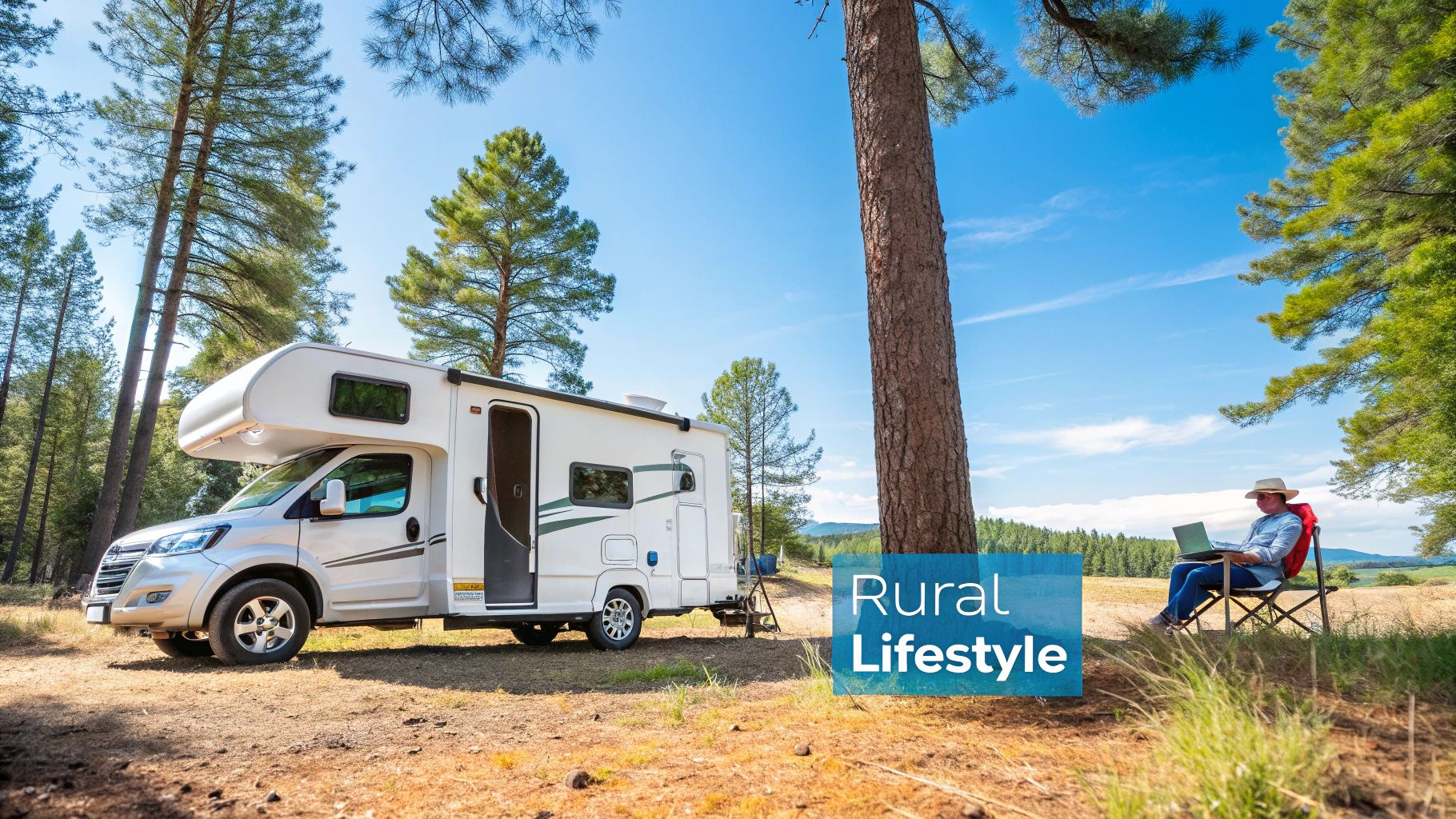
Let's be honest: the "best" rural unlimited internet isn't a single product. The perfect plan for you is completely tied to how you actually live and use the web. Are you juggling back-to-back video calls for work, or is your home a whirlwind of 4K streaming, online gaming, and virtual classrooms all at once?
To help you figure this out, let's walk through a few common scenarios. Think of these as stories about different rural users. By seeing their specific needs and the challenges they face, you'll probably see a bit of your own situation and be able to zero in on the tech that makes the most sense. This way, you find a plan that doesn’t just work—it works for you.
Scenario One: The Remote Worker
First up, meet the "Remote Worker." They’ve happily ditched the city commute for a home office with a much better view. The catch? Their entire livelihood now hinges on a rock-solid internet connection. A dropped video call isn't just a minor glitch; it looks unprofessional and can put important projects at risk.
This person needs an internet connection that puts a premium on low latency for crystal-clear calls and fast upload speeds to send massive files to clients without a second thought. Reliability is the name of the game, and they absolutely can't afford lag spikes during business hours.
Top Needs for the Remote Worker:
- Low Latency (Ping): Absolutely critical for video conferences that don't stutter and for real-time collaboration. Anything under 50ms is what you're aiming for.
- High Upload Speeds: You need this for sending presentations, design files, or chunks of code without staring at a progress bar all day. A minimum of 10 Mbps upload is a solid starting point.
- Consistent Performance: The connection has to be a steady workhorse from 9-to-5, with no random drops or frustrating slowdowns.
For this kind of setup, 5G Fixed Wireless is often the hero. It has the low latency and beefy upload speeds needed for a serious remote work environment, giving you a stable connection that can go toe-to-toe with what you'd find in the city.
Scenario Two: The Streaming Family
Now, let's pop in on the "Streaming Family." In this house, the internet is the unsung hero working overtime, 24/7. Mom and Dad are kicking back with a 4K movie, one kid is logged into an online class, and another is in a heated online gaming battle.
Their biggest need is simple: raw bandwidth. They need an internet pipe wide enough to handle all these high-demand activities at the same time without anyone's screen freezing into the dreaded buffering wheel. Upload speed isn't as big of a deal here, but massive download capacity is non-negotiable.
Top Needs for the Streaming Family:
- High Download Speeds: To keep multiple 4K streams, game downloads, and casual browsing running smoothly, they need at least 100 Mbps.
- True Unlimited Data: This family will burn through data like you wouldn't believe. A plan with a sneaky low data cap or a harsh deprioritization threshold will kill the fun fast.
- Whole-Home Coverage: The Wi-Fi signal has to be strong everywhere, from the basement gaming den to the upstairs bedrooms.
A high-capacity 5G plan is a perfect match here, as it can easily juggle the heavy download demands. The key is to pair it with a mesh Wi-Fi system to blanket the entire house in a strong, reliable signal. No more dead spots, and a lot more happy family members.
Scenario Three: The Full-Time RVer
Finally, let's catch up with the "Full-Time RVer," whose home is wherever they decide to park. One week they might be at a campsite with a decent cell signal, the next they could be boondocking in a national forest, miles from the nearest tower.
For them, it's all about flexibility and a wide coverage map. They need a rural unlimited internet solution that travels with them and adapts to new locations on the fly. For anyone embracing this kind of freedom, a dependable connection is the key to supporting a digital nomad lifestyle and staying in touch from the road.
Top Needs for the Full-Time RVer:
- Nationwide Coverage: The service has to work across the country, not just in one corner of it.
- Location Independence: They need an option that isn't bolted to a physical address and can be fired up easily at every new spot.
- A Reliable Backup Plan: One single solution probably won't cut it. Having a Plan B for those truly off-grid spots is crucial.
The best setup for an RVer is usually a mix of technologies. A 5G mobile internet plan from a carrier with a huge national network acts as their primary connection. But for those adventures deep in the backcountry, a mobile-friendly satellite service like Starlink for RVs becomes an indispensable backup, guaranteeing a connection as long as you can see the sky.
Got Questions About Rural Unlimited Internet? We've Got Answers.
Jumping into the world of rural unlimited internet can feel like navigating a new frontier. Even with all the amazing new tech out there, it’s normal to have a ton of questions. It's easy to get tangled up in the technical jargon or just plain wonder if the promise of fast, reliable internet can actually hold up when you're miles from the nearest city.
We get it. To cut through the confusion, we’ve put together some of the most common questions we hear from folks looking to finally ditch their slow connection. Think of this as your straightforward, no-nonsense guide to making a smart decision for your home or RV.
Is Unlimited Rural Internet Really Unlimited?
This is the big one, and the honest answer is almost always "yes, but with a catch." When a provider says a plan is unlimited, you need to look for the fine print about a Fair Use Policy or data deprioritization.
Don't worry, they won't just shut you off. What usually happens is that after you use a massive amount of data in a month—we're talking a huge number like 1TB—they might "deprioritize" your traffic. All this means is your speeds could slow down a little bit during peak hours, like in the evening when everyone in your area is online.
For the typical family, this is something you’ll likely never even notice. But if you have a house full of power users—think multiple 4K streams, constant massive file downloads, and serious online gaming all at once—it’s definitely something to compare between providers.
Can I Get Internet Good Enough for Streaming and Gaming?
You absolutely can. Gone are the days when living in the country meant endless buffering wheels. Technologies like 5G Home Internet and the newer Low Earth Orbit (LEO) satellite systems are changing the game completely. They easily provide download speeds of 25+ Mbps, which is plenty of juice to stream your favorite shows and movies in stunning 4K.
Now, when it comes to online gaming, speed isn't the whole story. The real hero is latency, often called "ping." Think of it as your connection's reaction time.
- 5G connections are fantastic for gamers because they have naturally low latency, which is perfect for fast-paced, competitive online matches where every millisecond counts.
- Modern satellite services like Starlink have made incredible leaps forward, slashing latency compared to the old satellite tech. For the first time, this is making lag-free gaming a reality for tons of rural players.
What Is the Best Internet Option for an RV?
For life on the move, the name of the game is flexibility and coverage. You need a service that can keep up with you, whether you're parked in a fully-loaded campground or boondocking way off the beaten path.
A 5G-based mobile internet plan is a brilliant choice for your primary connection, especially when you’re traveling through areas with solid cell coverage. It's fast, dependable, and super easy to get running at each new spot.
But for those who crave true off-grid freedom, where cell towers are a distant memory, a mobile satellite service is unbeatable. As long as the dish can see the sky, you've got internet. Many serious RVers and digital nomads actually use a hybrid approach: a 5G plan for most of their travels and a satellite system as a bulletproof backup for their most remote adventures.
Do I Need a Professional to Install My Internet?
It really depends on the technology you go with. One of the best things about modern rural internet solutions is just how easy most of them are to set up yourself.
Most 5G and 4G providers now ship out simple self-install kits. You literally just plug in a gateway or router, follow a few quick steps on a smartphone app, and you can be online in minutes. It's that easy.
Traditional satellite internet, on the other hand, almost always needs a pro to come out. They have to mount the dish on your roof and painstakingly align it to hit a satellite in orbit. The newer LEO satellite options, however, are designed for DIY setup, with dishes that can find the signal all by themselves. Just be sure to ask about the installation process before you sign on the dotted line.
Ready to stop settling for slow, unreliable internet? At SwiftNet Wifi, we deliver high-speed, truly unlimited 5G internet designed specifically for rural homes and RV travelers. Get the speed you need for seamless streaming, gaming, and remote work, no matter where you are.
Check Your Availability and Get Connected Today!
#rv #rvlife #rvliving #rvlifestyle #rvrenovation #rvremodel
#rvtravel #rvcamping #rvadventures #ruralwifi #5gwifi
#5ginternet

